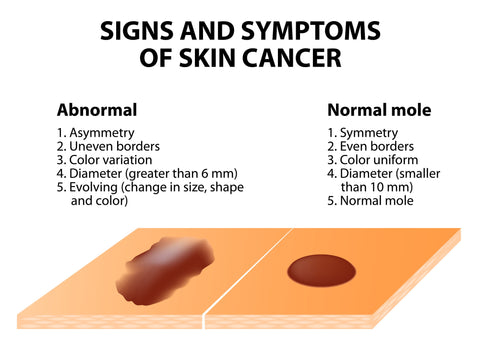on US orders over $100
on all US orders over $100

Checking regularly for skin cancer is a crucial step to protect yourself against the disease, as early detection makes treatment more likely to be successful. It's recommended that adults self-check their own skin at least once every three months, and have their doctor check it once a year. There are multiple types of skin cancer, so be certain you know what you're looking for!

The carcinoma varieties of skin cancer typically grow on the parts of the body that get the most sun exposure, such as the face, head, or neck. They can show up anywhere, but pay special attention to parts of your body that have been exposed excessively to the sun.
A basal cell carcinoma usually looks like a raised, smooth, pearly bump on the skin. Other signs include:
A squamous cell carcinoma tends to be a scaly bump or patch. Look for these signs:

Though melanoma is one of the most common types of cancer within the United States, it is also one of the most preventable forms of cancer. Approximately 90% of non-melanoma skin cancers and 85% of melanoma cases are associated with exposure to ultraviolet radiation from the sun. By raising awareness of the dangers of unprotected exposure and encouraging sun-safe habits, behaviors can be changed and lives can be saved.
It's imperative to talk about melanoma prevention, as well as how to properly detect it. The guideline "ABCDE" is extremely useful for identifying malignant melanoma:
Many people, especially those who have fair coloring or have had extensive sun exposure, periodically should check their bodies for suspicious moles and lesions. Have your primary health care doctor, or a dermatologist check any moles or spots that concern you. See your doctor if you notice any changes in the size, shape, color, or texture of pigmented areas.

Other guidelines
Not all skin cancers match these descriptions perfectly. Speak to your doctor if you notice any of the following:

If you think that a mole or other skin lesion has turned into skin cancer, your primary care doctor will most likely refer you to a dermatologist. The dermatologist will examine any moles in question, as well as the entire skin surface. Any lesions that are difficult to identify, or are thought to be skin cancer may then be checked. Tests for skin cancer include:
There's still plenty of summer left, so it's the perfect time to stock up on what you need to stay safe outdoors. Click here to visit our Sunscreen product collection!
Leave a comment